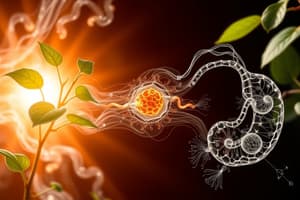Podcast
Questions and Answers
Which organelles are unique to plant cells and absent in animal cells?
Which organelles are unique to plant cells and absent in animal cells?
- Ribosomes
- Nucleus
- Mitochondria
- Vacuoles (correct)
What is the primary function of chloroplasts?
What is the primary function of chloroplasts?
- Photosynthesis (correct)
- Cellular respiration
- Storage of nutrients
- Protein synthesis
What happens to chlorophyll in plants during the cooler months?
What happens to chlorophyll in plants during the cooler months?
- It increases in concentration
- It turns blue
- It remains stable
- It begins to disassemble and break down (correct)
Which part of the chloroplast contains the thylakoids?
Which part of the chloroplast contains the thylakoids?
What is the main energy-carrying molecule produced by mitochondria?
What is the main energy-carrying molecule produced by mitochondria?
What is the primary function of chloroplasts in plants?
What is the primary function of chloroplasts in plants?
Which pathway is characterized as catabolic?
Which pathway is characterized as catabolic?
What type of energy do anabolic pathways generally require?
What type of energy do anabolic pathways generally require?
Which of these statements about mitochondria is true?
Which of these statements about mitochondria is true?
What do enzymes do in metabolic pathways?
What do enzymes do in metabolic pathways?
Which type of cellular process do plants primarily perform to create energy-rich carbohydrates?
Which type of cellular process do plants primarily perform to create energy-rich carbohydrates?
Animals and plants use glucose mainly for which purpose?
Animals and plants use glucose mainly for which purpose?
Which of the following processes is performed only by plants?
Which of the following processes is performed only by plants?
Flashcards
Photosynthesis
Photosynthesis
The process in which plants capture sunlight's energy and transform it into glucose, a type of sugar.
Cellular Respiration
Cellular Respiration
The process where cells break down glucose to create ATP, the cell's energy source.
Anabolic Pathway
Anabolic Pathway
A metabolic pathway that builds complex molecules from simpler ones, requiring energy.
Catabolic Pathway
Catabolic Pathway
Signup and view all the flashcards
Chloroplast
Chloroplast
Signup and view all the flashcards
Mitochondrion
Mitochondrion
Signup and view all the flashcards
ATP
ATP
Signup and view all the flashcards
Enzyme
Enzyme
Signup and view all the flashcards
Plant Cell Organelles
Plant Cell Organelles
Signup and view all the flashcards
Chloroplast Function
Chloroplast Function
Signup and view all the flashcards
Chlorophyll Location
Chlorophyll Location
Signup and view all the flashcards
Mitochondria's Role
Mitochondria's Role
Signup and view all the flashcards
Mitochondria Structure
Mitochondria Structure
Signup and view all the flashcards
Study Notes
Photosynthesis and Cellular Respiration
- Photosynthesis traps solar energy and transforms it into glucose, a carbohydrate.
- Photosynthesis occurs in chloroplasts.
- Photosynthesis is an anabolic pathway.
- Cellular respiration breaks down high-energy compounds (like glucose) to produce ATP.
- ATP is a direct source of energy for life.
- Cellular respiration occurs in mitochondria.
- Cellular respiration is a catabolic pathway.
Light
- Visible light is a type of electromagnetic radiation.
- Photons are packets of light.
- Solar energy is the ultimate energy source for living things.
- Special pigments in plants capture energy from photons to start photosynthesis.
Chloroplasts
- Chloroplasts are membrane-bound organelles found in plants and algae.
- They carry out photosynthesis.
- Thylakoids are flattened sacs inside chloroplasts, arranged in stacks called grana.
- The stroma is the inner solution within chloroplasts.
Chlorophyll
- Chlorophyll gives leaves their green color.
- Chlorophyll molecules trap solar energy.
- Leaves are the primary photosynthetic organs of most plants.
Mitochondria
- Mitochondria are the site of cellular respiration in cells.
- They are called the "powerhouses" of the cell because they produce ATP, the main energy-carrying molecule.
- Mitochondria are scattered throughout the cytoplasm of cells.
- Mitochondria have an inner and outer membrane.
- The inner membrane has folds called cristae that increase surface area for ATP production.
Animal vs. Plant Cells
- Vacuoles, chloroplasts, and cell walls are three key organelles found in plant cells but absent in animal cells.
- Vacuoles store water.
- Chloroplasts perform photosynthesis.
- Cell walls provide support to plant cells.
Metabolic Pathways
- Anabolic pathways require energy to build large molecules.
- Photosynthesis is an example of an anabolic pathway.
- Catabolic pathways release energy by breaking down molecules.
- Cellular respiration is an example of a catabolic pathway.
Enzymes
- Enzymes are biological catalysts that speed up reactions by lowering the activation energy.
- Enzymes are crucial for metabolic pathways to function at the temperatures of living systems.
Studying That Suits You
Use AI to generate personalized quizzes and flashcards to suit your learning preferences.




